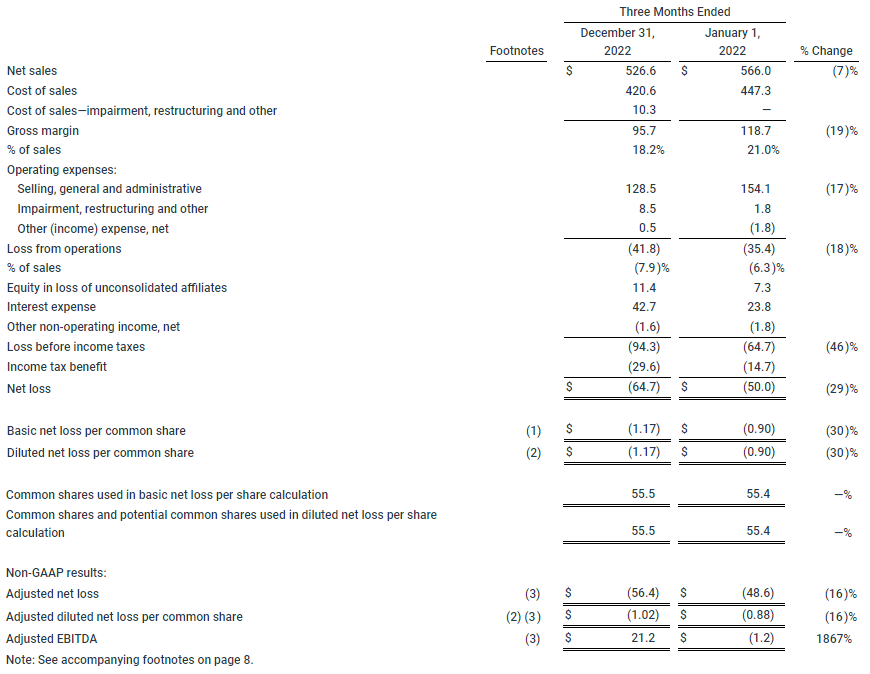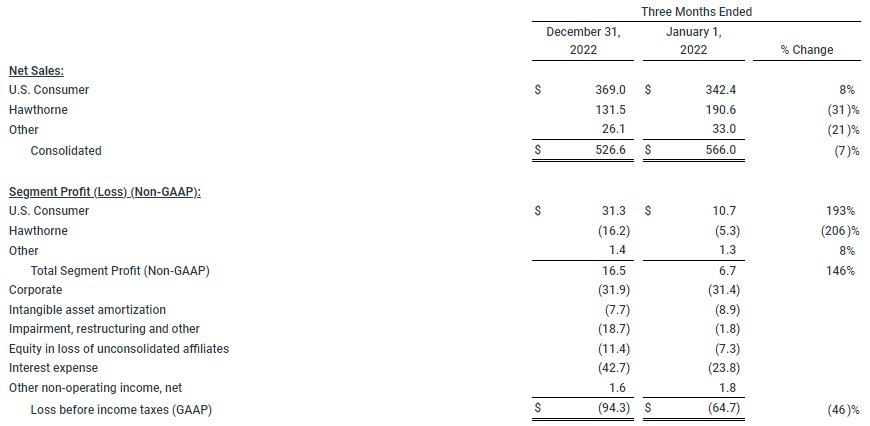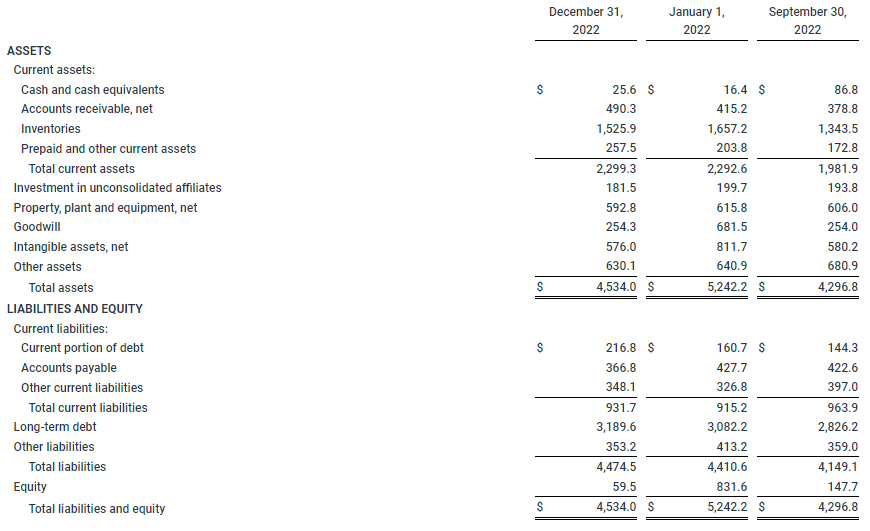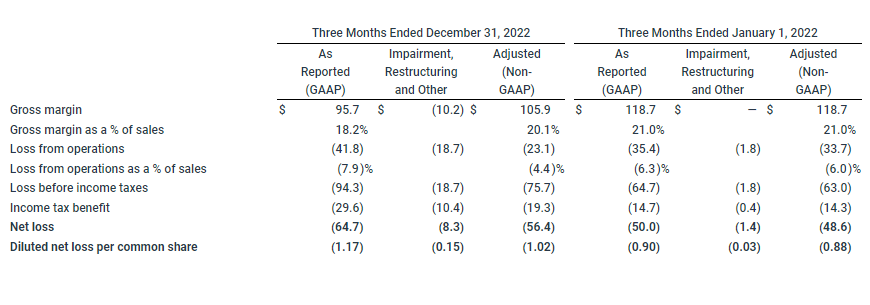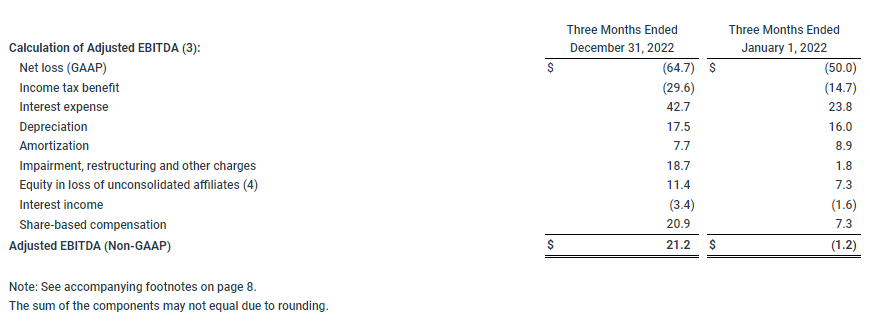![]()
ScottsMiracle-Gro Reports First Quarter Results
- U.S. Consumer Sales Up 8 Percent YoY
- First Quarter GAAP Loss of $1.17 Per Share; non-GAAP Loss of $1.02 Per Share
- Project Springboard to Exceed $185 Million Annualized Savings
- Net Leverage Ratio Within Covenant at 5.9X
- Full-Year Sales Guidance Updated for Lower Hawthorne Outlook
- $1 Billion Free Cash Flow Target Over Next Two Years Reaffirmed
MARYSVILLE, Ohio, Feb. 01, 2023 (GLOBE NEWSWIRE) — The Scotts Miracle-Gro Company (NYSE: SMG), the world’s leading marketer of branded consumer lawn and garden as well as indoor and hydroponic growing products, today announced results for its fiscal first quarter ended December 31, 2022.
“The first quarter reflects our disciplined approach to reorient the business and strengthen the operational and financial performance of the Company,” said Jim Hagedorn, chairman and CEO. “We have further positioned ScottsMiracle-Gro for long-term growth and shareholder value. We are comfortably within our leverage requirement and expect to remain on this trajectory through the fiscal year. As for Project Springboard, we have line of sight to annualized savings above the initial $185 million target, creating opportunities to reinvest in the business.”
Record December shipments in the U.S. Consumer business contributed to a strong early season buildout demonstrating confidence in the lawn and garden season. Our focus now is on early consumer engagement and POS lifts in coordination with retail partners.
 Jim Hagedorn, chairman and CEO
Jim Hagedorn, chairman and CEO
While Hawthorne continues to manage through a challenging market, we are committed to returning the business to profitability by the end of this fiscal year. Overall, we are in a stable place and are well prepared to execute on our full-year plan.
First Quarter Highlights
U.S. Consumer net sales increased 8 percent versus the same period last year, reflecting a strong partnership with our retailers on first half load-in and precision execution by our operators to deliver record December shipments. However, with continued pressure on the hydroponic industry as a whole, the smaller Hawthorne segment sales decreased 31 percent versus prior year. Total Company sales declined 7 percent in the quarter to $527 million. Due to seasonality, the first quarter typically represents less than 15 percent of full year sales.
Both phases of Project Springboard are now expected to deliver $185 million of annualized savings in fiscal 2023 ahead of schedule with line of sight to additional savings through fiscal 2024, reflecting the high level of financial discipline company-wide and partially mitigating higher interest expense and volume loss at Hawthorne this year.
“I am impressed by the deep talent at SMG and the high level of transparency, collaboration and execution against our financial targets,” said Matt Garth, who became chief financial officer in the first quarter. “The work of the team and our latest results have inspired my confidence in our ability to maintain compliance with our covenants while investing in our strategic initiatives, which should deliver profitable growth in 2024 and beyond.”
The Company reported a GAAP loss of $1.17 per share. Non-GAAP adjusted earnings, which is the basis of the Company’s guidance, was a loss of $1.02 per share.
Financial Results
First Quarter Details
For the quarter ended December 31, 2022, company-wide sales decreased 7 percent to $526.6 million. U.S. Consumer segment sales increased 8 percent to $369.0 million from $342.4 million last year. Hawthorne segment sales decreased 31 percent to $131.5 million, compared with $190.6 million during the same period a year ago, reflecting the continued challenges in the hydroponic industry.
GAAP and non-GAAP adjusted gross margin rates for the quarter were 18.2 percent and 20.1 percent, respectively. The non-GAAP gross margin excludes $10.2 million of impairment, restructuring and other non-recurring costs. The gross margin rate was 21 percent in the first quarter last year on both a GAAP and non-GAAP basis. Higher commodities and unfavorable fixed cost leverage, primarily related to volume loss at Hawthorne and lower production volumes in our U.S. consumer business, continue to drive the gross margin rate declines as expected for the quarter. Those pressures were partially offset by last year’s price increases, earlier than planned Springboard distribution savings and favorable segment mix due to the decline in the lower-margin Hawthorne business.
Project Springboard has also contributed to a 17 percent reduction in SG&A, to $128.5 million from $154.1 million a year ago.
Interest expense increased $18.9 million year over year to $42.7 million, driven by an increase in average borrowings and higher interest rates. The Company’s average debt-to-EBITDA ratio at the end of the quarter was 5.9 times, within the covenant maximum of 6.25 times. The maximum increases to 6.5 times for the next two quarters before returning to 6.25 times in the fourth quarter of the fiscal year.
The Company reported a GAAP loss of $64.7 million, or $1.17 per share, compared with a prior year loss of $50.0 million, or $0.90 per share. The current and prior results include pre-tax impairment, restructuring and other non-recurring charges of $18.7 million and $1.8 million, respectively. Excluding these charges, the non-GAAP adjusted loss in the quarter was $56.4 million, or $1.02 per share, compared with a loss of $48.6 million, or $0.88 per share, in the first quarter of 2022.
Fiscal 2023 Outlook
The Company updated its outlook for fiscal 2023 as compared to fiscal 2022 as follows:
- 20 to 30 percent decline in Hawthorne segment net sales
- Low single-digit decline in total Company net sales
- Low single-digit decline in gross margin rate
- Low single-digit percentage growth in adjusted operating income
- Low single-digit percentage growth in adjusted EBITDA
- Interest expense increase of approximately $60 million
- Effective tax rate of 26 to 27 percent
- Free cash flow of $1 billion over the next two years
Management will outline its 2023 expectations in more detail during its scheduled conference call with the investment community at 9 a.m. Eastern Time today.
Conference Call and Webcast Scheduled for 9 a.m. ET Today, February 1
The Company will discuss results during a webcast and conference call today at 9:00 a.m. ET. To participate in the conference call, please register in advance at this link. Upon registration, all telephone participants will receive the dial-in number along with a unique PIN number that can be used to access the call. If you do not anticipate asking a question, we recommend joining via the live webcast on the Company’s investor relations website at http://investor.scotts.com. The replay of the conference call will also be available on the Company’s website, where an archive of the press release and any accompanying information will remain available for at least a 12-month period.
About ScottsMiracle-Gro
With approximately $3.9 billion in sales, the Company is the world’s largest marketer of branded consumer products for lawn and garden care. The Company’s brands are among the most recognized in the industry. The Company’s Scotts®, Miracle-Gro® and Ortho® brands are market-leading in their categories. The Company’s wholly-owned subsidiary, The Hawthorne Gardening Company, is a leading provider of nutrients, lighting and other materials used in the indoor and hydroponic growing segment. For additional information, visit us at www.scottsmiraclegro.com.
The Company divides its operations into three reportable segments: U.S. Consumer, Hawthorne and Other. U.S. Consumer consists of the Company’s consumer lawn and garden business in the United States. Hawthorne consists of the Company’s indoor and hydroponic gardening business. Other primarily consists of the Company’s consumer lawn and garden business outside the United States. This identification of reportable segments is consistent with how the segments report to and are managed by the chief operating decision maker of the Company. In addition, Corporate consists of general and administrative expenses and certain other income and expense items not allocated to the business segments.
The performance of each reportable segment is evaluated based on several factors, including income (loss) before income taxes, amortization, impairment, restructuring and other charges (“Segment Profit (Loss)”), which is a non-GAAP financial measure. Senior management uses Segment Profit (Loss) to evaluate segment performance because they believe this measure is indicative of performance trends and the overall earnings potential of each segment.
The following tables present financial information for the Company’s reportable segments for the periods indicated:
(1) Basic income (loss) per common share amounts are calculated by dividing net income (loss) by the weighted average number of common shares outstanding during the period.
(2) Diluted income (loss) per common share amounts are calculated by dividing net income (loss) by the weighted average number of common shares, plus all potential dilutive securities (common stock options, performance shares, performance units, restricted stock and restricted stock units) outstanding during the period.
(3) Reconciliation of Non-GAAP Measures
Use of Non-GAAP Measures
To supplement the financial measures prepared in accordance with U.S. generally accepted accounting principles (“GAAP”), the Company uses non-GAAP financial measures. The reconciliations of these non-GAAP financial measures to the most directly comparable financial measures calculated and presented in accordance with GAAP are shown in the tables above. These non-GAAP financial measures should not be considered in isolation from, or as a substitute for or superior to, financial measures reported in accordance with GAAP. Moreover, these non-GAAP financial measures have limitations in that they do not reflect all the items associated with the operations of the business as determined in accordance with GAAP. Other companies may calculate similarly titled non-GAAP financial measures differently than the Company, limiting the usefulness of those measures for comparative purposes.
In addition to GAAP measures, management uses these non-GAAP financial measures to evaluate the Company’s performance, engage in financial and operational planning and determine incentive compensation because it believes that these measures provide additional perspective on and, in some circumstances are more closely correlated to, the performance of the Company’s underlying, ongoing business.
Management believes that these non-GAAP financial measures are useful to investors in their assessment of operating performance and the valuation of the Company. In addition, these non-GAAP financial measures address questions routinely received from analysts and investors and, in order to ensure that all investors have access to the same data, management has determined that it is appropriate to make this data available to all investors. Non-GAAP financial measures exclude the impact of certain items (as further described below) and provide supplemental information regarding operating performance. By disclosing these non-GAAP financial measures, management intends to provide investors with a supplemental comparison of operating results and trends for the periods presented. Management believes these non-GAAP financial measures are also useful to investors as such measures allow investors to evaluate performance using the same metrics that management uses to evaluate past performance and prospects for future performance. Management views free cash flow as an important measure because it is one factor used in determining the amount of cash available for dividends and discretionary investment.
Exclusions from Non-GAAP Financial Measures
Non-GAAP financial measures reflect adjustments based on the following items:
- Impairments, which are excluded because they do not occur in or reflect the ordinary course of the Company’s ongoing business operations and their exclusion results in a metric that provides supplemental information about the sustainability of operating performance.
- Restructuring and employee severance costs, which include charges for discrete projects or transactions that fundamentally change the Company’s operations and are excluded because they are not part of the ongoing operations of its underlying business, which includes normal levels of reinvestment in the business.
- Costs related to refinancing, which are excluded because they do not typically occur in the normal course of business and may obscure analysis of trends and financial performance. Additionally, the amount and frequency of these types of charges is not consistent and is significantly impacted by the timing and size of debt financing transactions.
- Discontinued operations and other unusual items, which include costs or gains related to discrete projects or transactions and are excluded because they are not comparable from one period to the next and are not part of the ongoing operations of the Company’s underlying business.
The tax effect for each of the items listed above is determined using the tax rate and other tax attributes applicable to the item and the jurisdiction(s) in which the item is recorded.
Definitions of Non-GAAP Financial Measures
The reconciliations of non-GAAP disclosure items include the following financial measures that are not calculated in accordance with GAAP and are utilized by management in evaluating the performance of the business, engaging in financial and operational planning, determining incentive compensation and determining the amount of cash available for dividends and discretionary investments, and by investors and analysts in evaluating performance of the business:
Adjusted gross margin: Gross margin excluding impairment, restructuring and other charges / recoveries.
Adjusted income (loss) from operations: Income (loss) from operations excluding impairment, restructuring and other charges / recoveries.
Adjusted income (loss) before income taxes: Income (loss) before income taxes excluding impairment, restructuring and other charges / recoveries, costs related to refinancing and certain other non-operating income / expense items.
Adjusted income tax expense (benefit): Income tax expense (benefit) excluding the tax effect of impairment, restructuring and other charges / recoveries, costs related to refinancing and certain other non-operating income / expense items.
Adjusted net income (loss): Net income (loss) excluding impairment, restructuring and other charges / recoveries, costs related to refinancing and certain other non-operating income / expense items, each net of tax.
Adjusted diluted net income (loss) per common share: Diluted net income (loss) per common share excluding impairment, restructuring and other charges / recoveries, costs related to refinancing and certain other non-operating income / expense items, each net of tax.
Adjusted EBITDA: Net income (loss) before interest, taxes, depreciation and amortization as well as certain other items such as the impact of the cumulative effect of changes in accounting, costs associated with debt refinancing and other non-recurring or non-cash items affecting net income (loss). The presentation of adjusted EBITDA is intended to be consistent with the calculation of that measure as required by the Company’s borrowing arrangements, and used to calculate a leverage ratio (maximum of 6.25 at December 31, 2022) and an interest coverage ratio (minimum of 3.00 for the twelve months ended December 31, 2022).
For the three months ended December 31, 2022, the following items were adjusted, in accordance with the definitions above, to arrive at the non-GAAP financial measures:
- During fiscal 2022, the Company began implementing a series of organizational changes and initiatives intended to create operational and management-level efficiencies. As part of this restructuring program, the Company is reducing the size of its supply chain network, reducing staffing levels and implementing other cost-reduction initiatives. During the three months ended December 31, 2022, the Company incurred costs of $9.5 million in the “Cost of sales—impairment, restructuring and other” line in the Condensed Consolidated Statements of Operations and $5.0 million in the “Impairment, restructuring and other” line in the Condensed Consolidated Statements of Operations primarily related to employee termination benefits, facility closure costs and impairment of property, plant and equipment associated with this restructuring initiative.
(4) Equity in income / loss of unconsolidated affiliates is excluded from the calculation of non-GAAP Adjusted EBITDA. This exclusion is consistent with the calculation of that measure as required by the Company’s borrowing arrangements. This change was first reflected in the calculation of Adjusted EBITDA during the fourth quarter of fiscal 2022. The prior period amounts have been reclassified to conform to the revised calculation.


